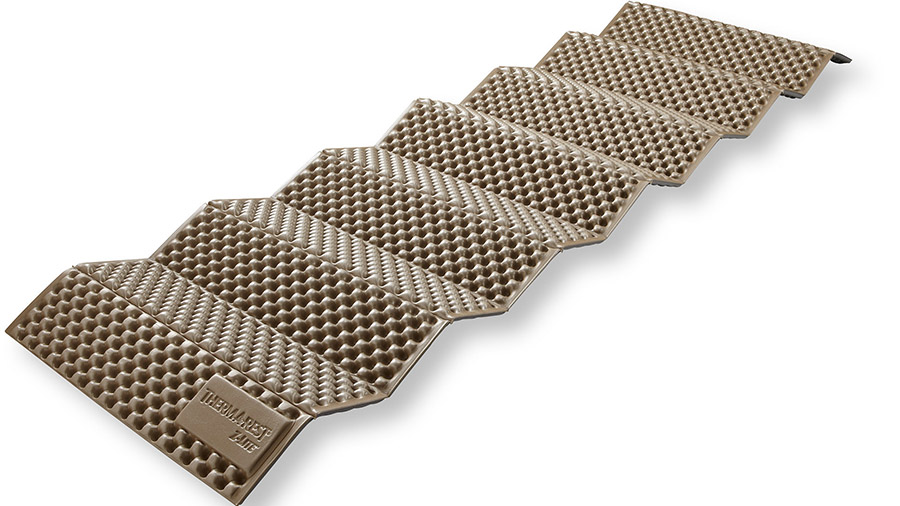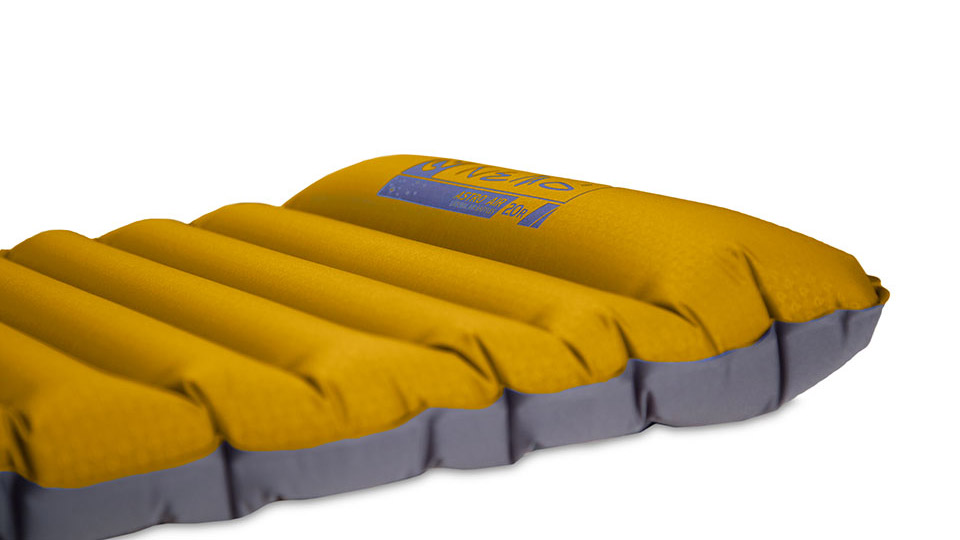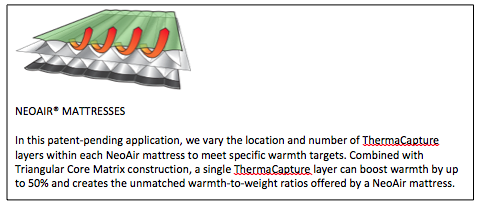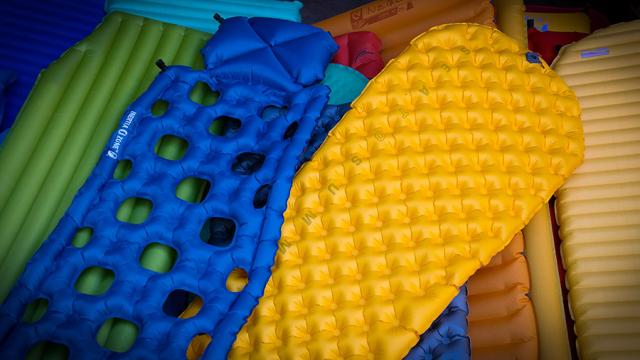As important for keeping you warm at night as a sleeping bag and the difference between a good night’s sleep and no sleep at all, sleeping pads are one of the most important things you can take with you outdoors. And, the latest generation is better than ever. Here’s everything we learned about them while conducting an exhaustive comparison test.
Look for that comparison in the very near future, it will give you substantial buying advice. This article is intended to accompany that, providing you with all the information, tech details and knowledge we’ve picked up over the last couple months of testing, interviewing and destroying pads.
That test and this article does not encompass inflatable air mattresses of the type you’ll use at home for visiting in-laws and similar. While they can work for family car camping, they’re heavy, very puncture prone and totally lack insulation, making them less ideal for the outdoors than the purpose-designed sleeping pads described here and tested in our forthcoming comparison.
Types: You’ve got three basic types of pad: closed-cell foam, self-inflating foam-and-air designs and inflatable pads.

Closed-Cell Foam Pads are the simplest, cheapest and most rugged. You can find basic rolls of foam at surplus stores for as little as $US10 or just cut an egg crate mattress topper to size. But, if you actually want some padding between your shoulders, hips and the ground, you’ll want a proper sleeping pad designed to both insulation and cushion your body. Therm-A-Rest’s Z Lite SOL starts at $US35 and offers both a good R-Value (2.6) and a modicum of comfort. While closed-cell foams can be light, they don’t pack small, so you’ll be strapping them to the outside of your pack.

Self-Inflating Pads are the type you likely associate with the Therm-A-Rest brand. They invented this style way back in the ’70s and you probably used one in Boy Scouts. Basically, they’re a layer of porous foam enclosed inside a Nylon pocket. You unroll them and open a valve, allowing the foam to absorb air and inflate. These provide pretty good insulation and superior comfort to closed-cell foam pads in a reasonably affordable package, but don’t pack nearly as small or provide nearly as much comfort as inflatables.

You blow Inflatable Pads up with your mouth, typically creating a thick, comfortable cushion for the best possible sleep. The challenge then lies in adequately supporting your body and providing insulation. The latest generation of pads differs from their raft-like predecessors in the use of lateral baffles and several clever solutions to the insulation problem. If you prioritise sleeping comfort, then these are the pads you want.
What makes the latest generation of modern inflatable sleeping pads so comfortable? We asked Brandon Bowers, the product manager for Therm-A-Rest. “Modern sleeping pads are an enormous jump from the pool float-type air mats or blue foam rolls many of us used as kids,” he explains. “Take our lightest inflatable pad, the NeoAir XLite ($US141), for example. It provides approximately three times as much warmth thanks to its uniquely designed interior combining baffled air channels with heat-reflective layers to keep the pad lightweight and warm. It’s 6cm thick, has an R-Value of 3.2 and weighs just 340g. With zero foam, it also rolls up to a package the size of a one-litre Nalgene.”
What’s “R-Value” and how can you use that number? It’s a measure of thermal resistance. The higher the number, the better the pad will insulate; But, don’t put too much faith in the numbers provided by manufacturers. “The industry has not agreed on a standardised test method,” says Nemo senior product developer Tom Bath. Why? He goes on to explain that developing a methodology which is both financially accessible for smaller brands and able to accurately represent real world use has proved nearly impossible. A pad’s ability to insulate is reduced by compression, so the heavier you are, the less insulation it will provide. Inflation pressures, which are user variable, also impact that ‘squish’ and there’s virtually no way to account for pads incorporating holes or recesses; such designs rely on the sleeping bag ‘lofting’ into those gaps for insulation.
As a general guide, an R-value in the 2s should manage temperatures down to about freezing, in the 3s should take you down to about -7C, a high 4 should get you down to -18C, and anything beyond that will take you lower. R-Values are nice and linear, a 3 is three times as insulative as a 1 and a 6 is twice as warm as a three. But, all that will vary depending on your own, unique body, the sleeping bag you use and the way in which you sleep. And, like sleeping bags, the numbers quoted by manufacturers should be considered an absolute extreme, measured with the pad unloaded. Take a warmer pad than you’re likely going to need for a more comfortable night.
“The comfort level each user experiences is influenced by many factors,” continues Tom. “This includes metabolic rate, type of shelter, insulation level of the type of ground you’re sleeping on (snow, dirt, platform), clothing worn when sleeping, sleeping position, etc.” Nemo quotes the insulation values of its pads in comfortable temperature ranges as a result, but the real takeaway here is that you have to take a pad out into the woods and use it to see how well it sleeps, which is exactly what we did.
Types Of Insulation: Foam, baffles, heat reflective materials, down and its synthetic alternatives. Which is best?
Foam: Can be effective, but is both bulky and heavy.
Baffles: Control air flow inside an inflatable pad, keeping cold air near the cold ground and warm air near your warm body. Vital in an inflatable pad, you move the air around inside every time you shift your weight.

Heat Reflective Materials: Think “foil”, or one of those emergency space blankets. They reflect heat back at your body. Effective and light, the downside is that they crinkle like a bag of chips as your body moves.
Down: Extraordinarily effective and very light, the effectiveness of down is nevertheless diminished by the moisture from your breath that transfers to the pad’s interior as you blow into it.
Primaloft: A synthetic, lofted alternative to down, is an excellent option for insulation inside a sleeping pad. Air from your lungs inherently passes some moisture into the interior of a pad as you inflate it and, unlike down, Primloft won’t lose any of its insulation when it gets damp. Primaloft is also easily laminated to the top layer of the pad, giving you insulation where you need it most — next to your body. And because it’s soft, it’s silent.
Noise: Inflatable air mattresses can be incredibly noisy, something caused both by outer layers that “swish” against your sleeping bag and tent and heat reflective baffles made from a crinkly, foil-like material. This is something we address in the comparison, in it you’ll find which inflatables are annoyingly loud and which ones aren’t.
Quality: Won’t an inflatable pad spring a leak? Well, I regularly camp with an 85lbs half-wild dog and without a tent, placing my pad directly on rocks, twigs and other surfaces. And I haven’t had a pad fail in years. Well, at least until the comparison test, in which one of the lightest pads did fail due to its incredibly thin material. As a general rule, pads from quality brands like Therm-A-Rest, Nemo, Exped, Klymit, Sea-to-Summit, Big Agnes, REI etc should hold air for years and years, so long as you’re reasonably careful with them. Keeping the outside materials clean with soap and water and taking care to ensure no debris fouls the valves can help there.
Valves: Various pad manufacturers try to re-invent the wheel when it comes to valves. During the comparison, we found that simple, twist-type valves small enough to block with your tongue during inflation worked best. Fancier types that push open and closed, which feature large diameters or separate inflation/deflation ports, layers or whatever just proved complicated and difficult to use.
Pumps: Footpumps, integrated pumps and stuff sack pumps; consider them all a gimmick. The general idea with them is that you may be so out of breath after a hike that inflating your pad will be hard. Know what’s harder? Trying to make one of these designs work. Sit down, take a five-minute break, then blow your pad up. Typically, we found most only take 15 or 20 breathes to do so. That’s not going to kill you.
The other reason given for pumps is to prevent warm, moist air from your lungs entering the pad. While that can be an issue, the extreme hassle and extended inflation times (up to 15 minutes in our test!) required eliminates any benefit. Don’t pick a pad with down insulation and store any pad unrolled, with its valve open, in a warm, dry area at home.
If you blow up your pad long before you go to sleep and the temperature plummets in the meantime, just put in a few more breathes before you tuck in. Again, the extraordinary added complication of pumps just isn’t necessary.
Types Of Sleep: Do you sleep on your side, back or stomach? The answer influences the kind of pad you’ll need.
If you’re a side sleeper, you need a thick pad with lateral baffles (running across your body, from side to side). These provide the level of cushion and support you’ll need to keep hips and shoulders off the ground. Longitudinal baffles are the side sleeper’s enemy, you tend to get “stuck” in one of the grooves.
If you’re a stomach sleeper, then you’ll need a pad with levelest-possible sleeping surface and no integrated pillow, which will get in the way of your head. Even deep channels between lateral baffles will make you uncomfortable.
Back sleepers are lucky, you don’t need a ton of padding, so you can get away with a cheap, closed-cell foam pad if necessary. Or, you’ll benefit from the added comfort, insulation and support of a quality inflatable air mattress.
Size and Weight: The industry standard size for a sleeping pad is 183cm in length and 51cm width. If you have an integrated pad sleeve on your sleeping pad, you’ll need that 51cm width.
If you’re taller or shorter than 183cm, then you’ll want a longer or shorter pad, which are available. Size as closely as possible to your height to minimise the size and weight you need to carry.
3/4 and 1/2 length pads exist for those looking to sacrifice some comfort for weight. We don’t recommend them, full-length ultralight pads are so light and so comfortable, that the smaller designs are just unnecessary. Buy a better pad rather than a shorter one.
If you’re…big boned and want a wider pad, many manufacturers offer wider versions of their best pads. Be warned that 64cm or 76cm wide pads may not integrate with sleeping bag sleeves or fit in some ultralight, one-man tents. They will also obviously weigh more.
And, not all 51cm pads are created equal. Some designs have problems with the last inch or so on both sides literally collapsing if any weight is applied there, making their effective width 46cm or less. We’ll talk about which pads do that and which don’t in the comparison.

What’s With Those Pads With Holes In Them? An innovation from Klymit, the idea is that you can save weight by only putting support where the body absolutely needs it. Such pads also do without insulation, instead allowing your sleeping bag to “loft” into the holes for warmth. Surprisingly, we found them to be effective, but also found better options for comfort that are just as light.
A Good Night’s Sleep: In testing, we found it’s simplicity, a light weight, a decent amount of insulation and lateral baffles which proved the most comfortable, most portable and easiest to both inflate and deflate regardless of size, category or manufacturer.
